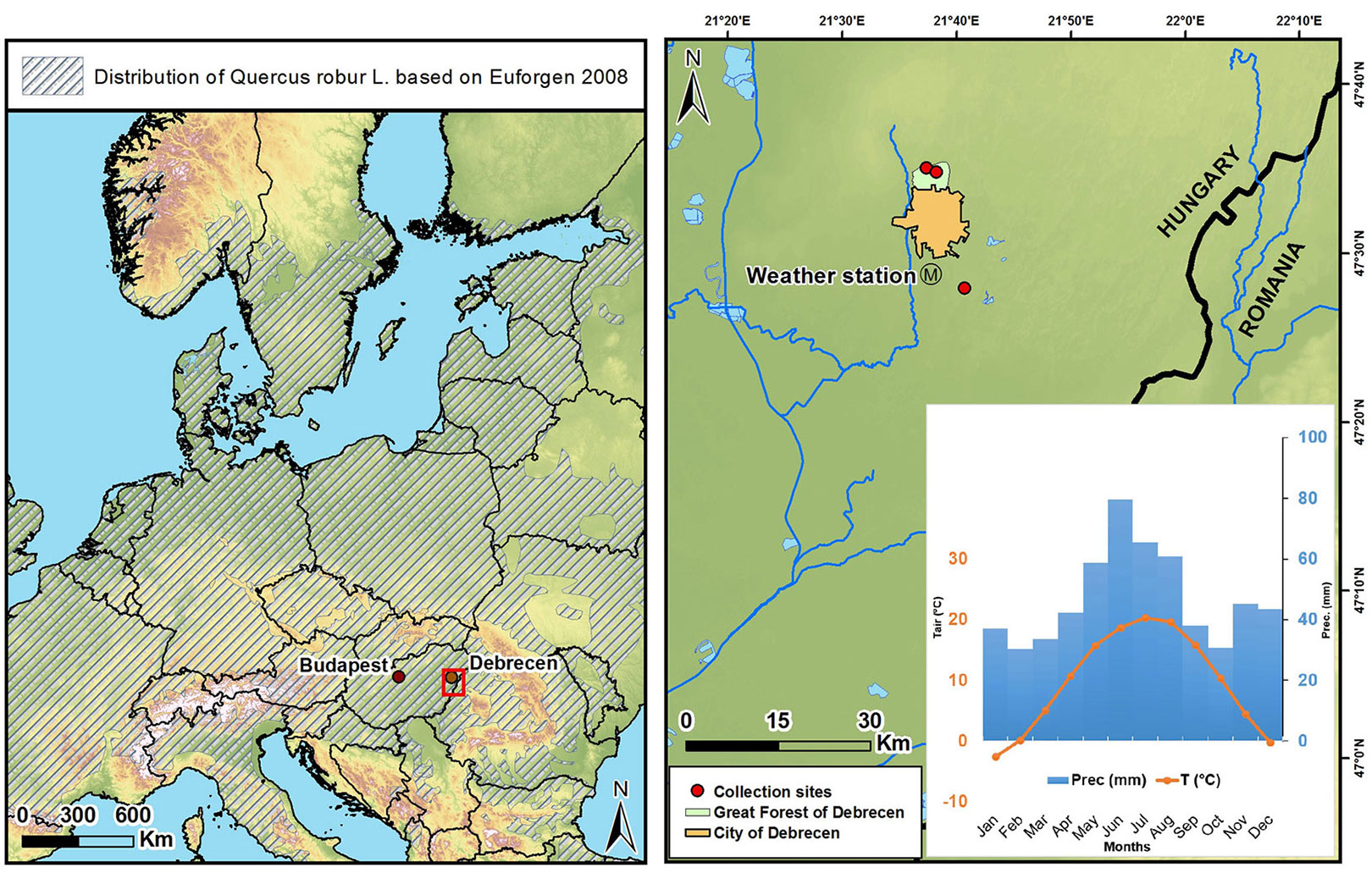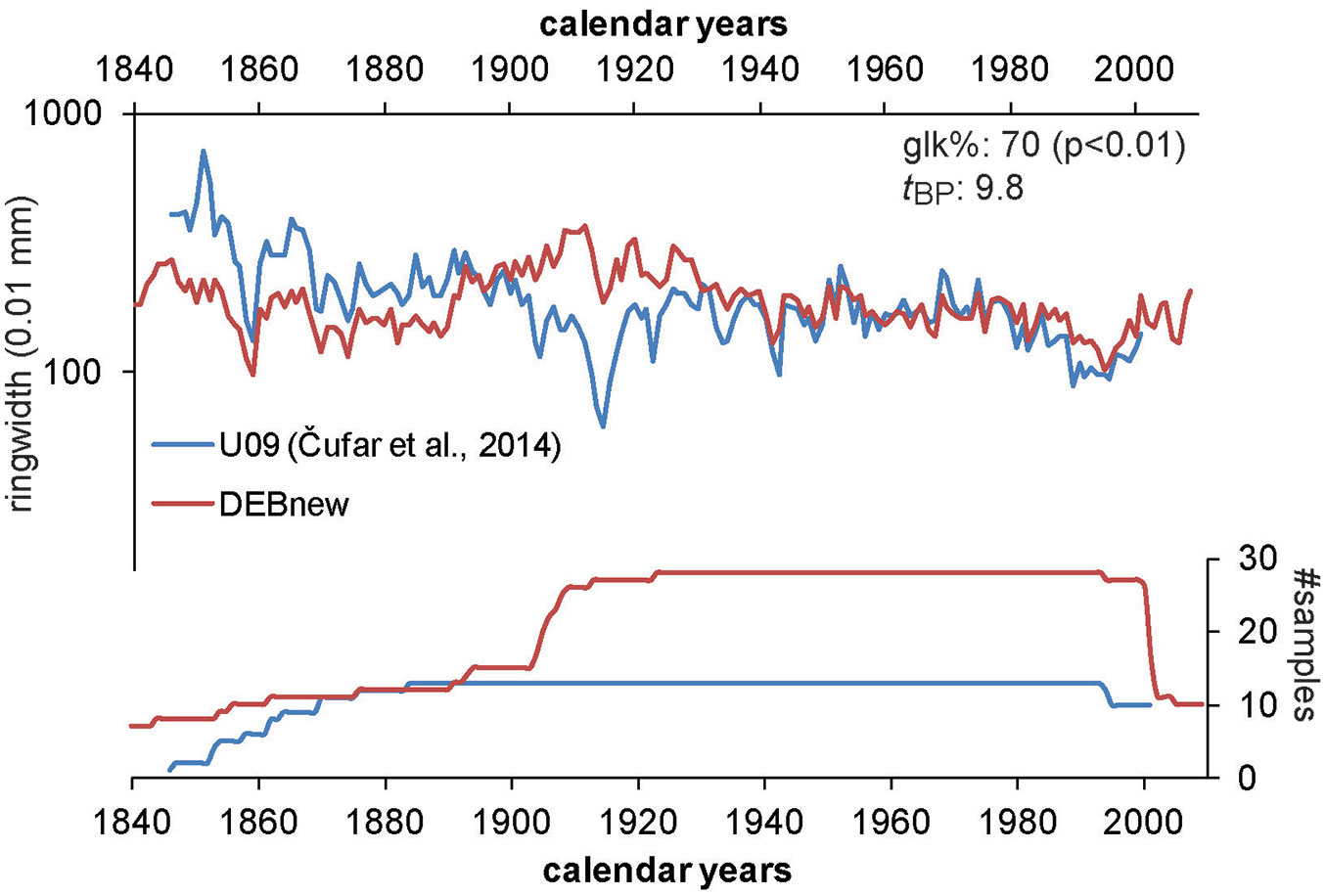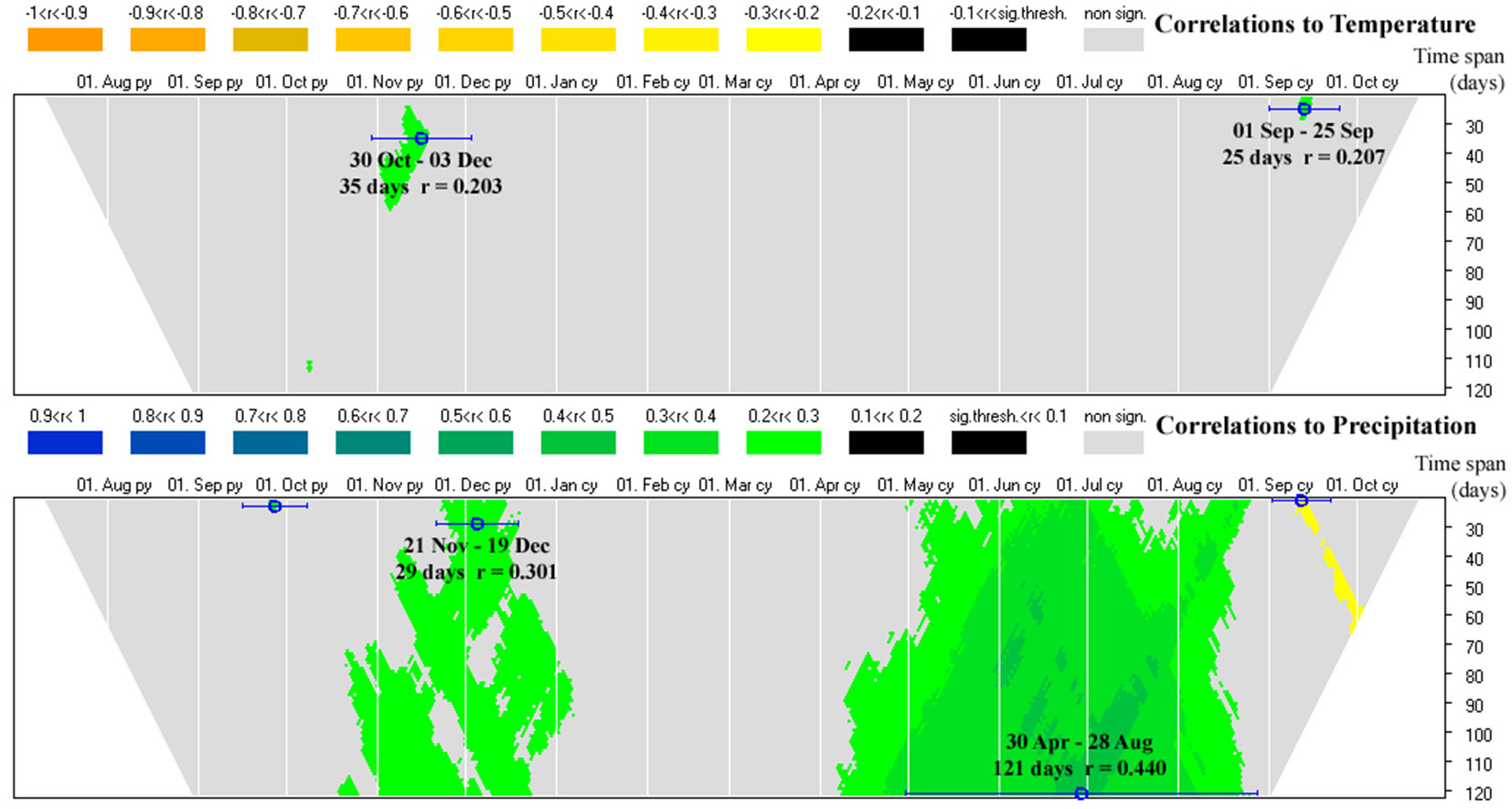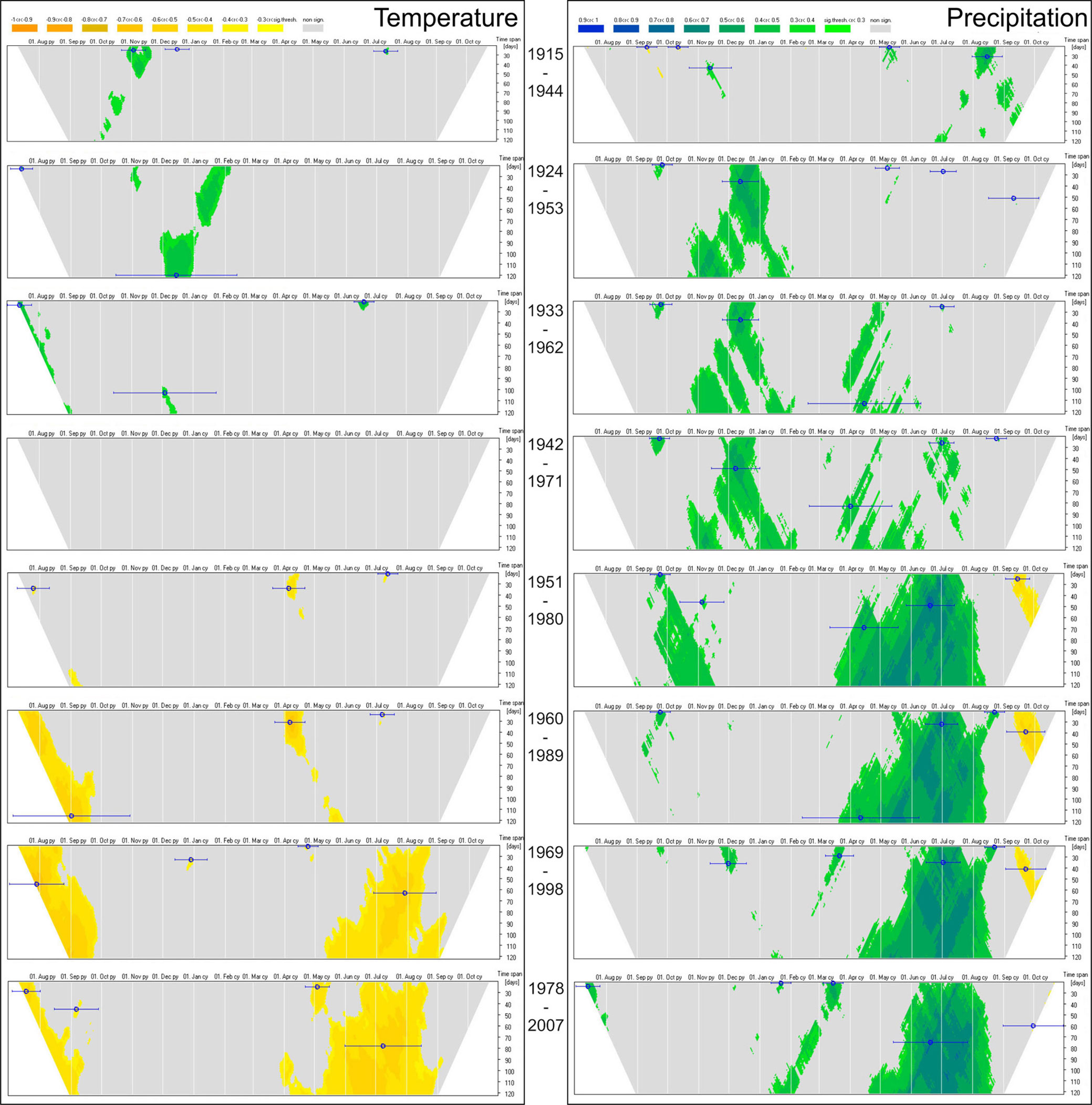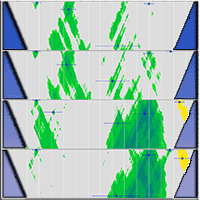
Growth-climate relations and the enhancement of drought signals in pedunculate oak (Quercus robur L.) tree-ring chronology in Eastern Hungary
iForest - Biogeosciences and Forestry, Volume 11, Issue 2, Pages 267-274 (2018)
doi: https://doi.org/10.3832/ifor2348-011
Published: Mar 29, 2018 - Copyright © 2018 SISEF
Research Articles
Abstract
This paper presents an analysis of the climatic factors affecting tree-ring growth in pedunculate oak (Quercus robur L.), one of the most important species of Hungarian forests. A 221-year oak chronology was elaborated, covering the period 1789 to 2009 AD. The daily climate data for a ~110 year stretch offered a detailed insight into the climate-growth relations. The correlation function reached a maximum (r > 0.4) in the case of precipitation in May-August, providing evidence that water availability is the main factor driving the oak growth in the eastern part of the Great Hungarian Plain. Although there was no significant linear relation with temperature in the long term, moving window correlation analysis revealed that temperature response changed substantially over the course of the 20th century. While positive correlation with winter temperature was characteristic in the first decades, later the response to summer temperature strengthened remarkably, reaching r = -0.569 by the end of the analysed period (years 1978-2007). While the vulnerability of oak to drought stress is common across Europe, in southern and central Europe high summer temperatures impair tree growth. The enhanced sensitivity of pedunculate oaks to the water balance in the eastern part of the Great Hungarian Plain allows to surmise the presence of an evolving tendency towards drought risk and vulnerability in the case of these oak stands.
Keywords
Dendroclimatology, Pedunculate Oak, Tree-rings, Hungary, Drought Signal
Introduction
Pedunculate oak (Quercus robur L.) is widely distributed across Europe ([14]), where it is among the most economically important deciduous forest trees. Noble oaks (Q. robur and Q. petraea) are the most in-demand timber species in Hungary, thanks to their aesthetic and technical qualities ([31]). Oak forests cover the second largest part of wooded areas in Hungary, and pedunculate and sessile oaks have the highest standing volume (23.4 % - [47]). The climate sensitivity of these two oak species is very similar ([12]), although Q. robur responds more strongly to water depletion than Q. petraea ([18]).
The frequency of pedunculate oak can reach levels of 50-70% in forest stands in East Hungary, though habitat suitability is usually suboptimal ([15]). Since local precipitation in the east Hungarian lowlands is usually insufficient to meet the water demand of the pedunculate oak ([19]), these oak forests depend on additional external water sources, such as groundwater ([32], [22]). Subsurface salt accumulation, observed in this subhumid climate ([22], [49]), should also be mentioned among the factors posing a challenge to growth and survival of oak stands in this region.
Despite its prominence in the silviculture of the region, relatively little is known about the response of the pedunculate oak to climate variability in Hungary. While the climate-growth relationships of the species have been intensively studied in the surrounding countries, such as Slovenia ([10], [11]), the Czech Republic ([12]), and Romania ([33]), a single study has been conducted in eastern Hungary so far ([27]). However, a decline in pedunculate oak stands has been documented in many regions over its native range ([21], [24]). A detailed understanding of the effects of climate on oak growth is therefore an important task facing forest science over the entire range of the species.
Although eastern Hungary is not at the margin of the species’ range (Fig. 1), its climatic conditions are somewhat outstanding. Indeed, in the last decades pedunculate oak stands at the border between Hungary and Romania have been affected by frequent droughts during all the four seasons, as pointed out by a recent analysis of European drought frequency and severity ([43]). The climatic signals affecting oak tree-ring growth in eastern-central Europe have been analysed in a recent study ([11]). The easternmost sampling site (U09) of a large study network was in eastern Hungary, where 12 tree-ring samples covering the period 1847-2001 were analyzed. The main patterns of variability among oak tree-ring chronologies across the network were evaluated by multivariate techniques, highlighting a distinct degree of variability at the U09 site. Correlation analysis based on monthly climate records over a 60 year period (1935-1995) revealed a positive correlation with precipitation occurring in previous December, as well as June and August of the current year, while a lack of correlation with monthly temperature records was observed for the east Hungarian oak chronology.
Fig. 1 - Location of the sampling sites. The map on the left shows the study area (red rectangle), along with the European distribution of pedunculate oak (Quercus robur L.). The right panel is a close-up view of the study area with the sampling sites and a Walter-Lieth climate diagram (inset chart) of the Debrecen meteorological station, based on daily data from the 1961-90 reference period.
In the present study we extended the above oak tree-ring dataset regarding the U09 site by sampling 25 living trees and 3 dead stems collected between 2001 and 2009 near Debrecen (Hungary), and by analyzing a 221-year oak chronology covering the period 1789-2009 AD. We analyzed such extended data set, along with a homogenised daily climate data from the nearby meteorological station over a period of ~110 years, with the aim of obtaining more detailed insights into the correlation between climate and the growth of pedunculate oak stands. Variable temporal width and moving correlations on daily climate data ([3]) were employed to account for short- and long-term climate influences on radial oak growth.
The present investigation contributes to improve our understanding of the spatial variability of the climatic response of oak trees in East-Central Europe ([11]), and provides information on the sensitivity of this important European forest species to climatic variability.
Materials and methods
Study site
The sampling sites were located in managed forests of the eastern part of the Great Hungarian Plain, in the Great Forest of Debrecen (Debreceni Nagyerdö), near the city of Debrecen, Hungary (Fig. 1). The Great Forest of Debrecen is the first natural reserve established in Hungary in 1939, and is one of the last natural sandy oak forest habitats with Lily-of-the-valley (Convallario-Quercetum roboris) in the country, where oaks grow in sparse forest patches surrounded by wooded steppe vegetation of sandy grasslands. The dominant species is the pedunculate oak (Quercus robur L.), along with the field maple (Acer campestre - [50]). The soil is mostly humic sandy soil with sporadic patches of brown earth on sand and banded brown forest soils ([38]); the corresponding WRB units are Arenosols and Luvisols, respectively ([30]).
Based on homogenized monthly climate data from the local meteorological station (47° 31′ N, 21° 38′ E, elevation 121 m a.s.l.), the mean annual air temperature is 9.8 °C, and annual precipitation is 565 mm for the period 1961-1990 ([34]). January is the coldest month (average temperature -2.6 °C), and July the warmest (+20.3 °C). Rainfall shows a seasonal peak in June (80 mm), while the driest months are February and October (35 mm). Such climatic data support the marginal suitability of the area with regard to the autoecology of pedunculate oak ([15]), as local rainfall hardly meets oak water demand in this region ([19]).
Based on annual climatic data for Debrecen, in the Great Forest the mean annual air temperature increased until the early 1930s, while a second significant increase was observed since the late 1980s (Fig. 2). Relatively wet conditions prevailed during the 1910s, and the total annual precipitation slightly decreased until the early 1990s. A regional evaluation of the climate trends also confirmed that the eastern part of the Great Hungarian Plain (including the study sites) significantly warmed up and became drier (to some extent) over the course of the 20th century ([4]).
Fig. 2 - Mean annual temperature (a) and total annual precipitation (b) for the period 1901-2010 at Debrecen (Hungary) based on data from the Hungarian National Meteorological Service. Long-term changes are shown by 3rd-order polynomial trends (thicker lines).
Sample collection
Cross-sectional disk samples were obtained from 15 living trees and 3 dead stems collected at several sites in the Great Forest of Debrecen between 2001 and 2004. Additionally, the 12 samples used to build the aforementioned U09 chronology ([11]) were included in the collection. We updated such chronology by including 10 additional cross-sectional disk samples from dominant pedunculate oak trees recently harvested at a nearby site (13 km southward - Fig. 1) in August 2009.
Sample preparation and measurement
The collected cross-sectional disks were sanded and polished before tree-ring analysis. Ring width measurements were performed at a resolution of 0.01 mm along two radii per disk using a LINTAB measuring table and TSAP-Win software ([39]). Ring width series were synchronized, initially by visual comparison ([45]), and then checked using the software COFECHA ([26]). Measurement and crossdating were performed using the facilities available at the Budapest Tree-Ring Laboratory, Dept. of Palaeontology, Eötvös Loránd University, Budapest, Hungary ([29]). Standard dendrochronological statistics such as the percentage of agreement (Gleichläufigkeit, glk% - [16]) and modified t value (tBP - [1]) were used to evaluate the results of crossdating.
Tree-ring chronology standardisation
In order to remove age-related trends and growth disturbances resulting from forest dynamics, tree-ring chronologies were standardised ([9]). A cubic spline with a 50% frequency cut-off at two-thirds of the series length was fitted ([7]) and an index was calculated as the ratio of the raw ring width data to the spline.
The mean chronology was calculated as a bi-weight robust mean and the “ars” chronology was selected, because the retained population-level autocorrelation is considered to be related to climatic variability ([8]). The stability of the chronological signal preserved in the index series was checked using the Expressed Population Signal (EPS) statistical method. EPS estimates how well a finite number of analysed samples represents the theoretical stand average; the widely accepted threshold is 0.85 ([52]). Mean interseries correlation (Rbar) and EPS were calculated using 41-yrs running windows. Variance adjustment was applied to minimize variance bias due to changing sample replication and the effect of fluctuating interseries correlation ([35]).
Climate data and statistical analyses
Quality-checked and homogenized data of daily precipitation and temperature were obtained from the local meteorological station in Debrecen (Fig. 1) covering the period from January 1st, 1901 to December 31th, 2010 ([34]). The CLIMTREG software ([3]) was used to assess the correlation of climatic variables with tree growth. CLIMTREG scans daily climate data using variable temporal windows requiring no monthly limits. The correlation analysis was performed on daily mean temperature and daily precipitation totals, starting from July of the previous year up to 31st October of the current year (488 days), grouped in segments of at least 21 days (three weeks) up to a maximum of 121 days (four months). Besides the assessment of the long-term mean climate response, a 31-yrs moving window correlation analysis was applied to test for the temporal stability of the climatic signal.
Finally, monthly potential evapotranspiration (PET - [46]) and the difference between monthly precipitation and evapotranspiration (P-PET) was calculated for the Debrecen station. The P-PET parameter was considered as an estimate of the climatic water balance ([40]).
Results
The 221-year oak tree-ring width chronology
The chronology obtained from the trees sampled at the Great Forest sites was in good agreement with the chronology constructed from the initial 12 oak trees representing the Debrecen site in the former network study (site code U09 - [11]), which evaluated the common climatic signals in oak tree rings in SE Central Europe (Fig. 3). Since climatological and soil conditions were relatively homogeneous among stands, the initial U09 data set and the newly collected data set were merged to develop an improved regional Q. robur ring-width chronology. However, two out of the 12 series of the initial U09 data set were discarded as they showed a low degree of correlation in their juvenile decades when the entire dataset was tested using COFECHA. Therefore, only ten series were retained from the U09 data set in the final chronology.
The final tree-ring width (TRW) chronology obtained from the merged data set spans over the period 1789-2009, including at least 5 trees with data from 1809 (Fig. 4). The ten samples originating from the newly added site had the effect of moving forward the latest date of the chronology by 8 years, while the historic earliest date was extended back by more than 50 years. The signal strength statistics confirmed the exceptionally robust chronological signal, as EPS was well above the 0.85 level (Fig. 4.).
Fig. 4 - Indices and signal strength statistics of the regional pedunculate oak chronology. (A) Tree-ring width indices. (B) Signal strength statistics calculated in 41-year running windows: (EPS) Expressed Population Signal ([52]), (Rbar) between-tree correlation. The grey dashed line represents the 0.85 EPS threshold. (C) The replication of the chronology (number of trees analysed) over the study period (1789-2009 AD).
Relations between pedunculate oak radial increment and climate
Climate-growth analysis using daily climate data provided a detailed picture of the long-term mean climate sensitivity of the pedunculate oak in east Hungary. A significant (p<0.01) positive correlation was found between the interannual variation in oak growth and summer precipitation (Fig. 5). The highest response (r=0.440, p<0.001) was found in the case of summer precipitation (30 April - 28 August). A secondary peak of correlation (r=0.296, p=0.002) was observed with the preceding late autumn-early winter precipitation (20 November - 18 December). Much weaker correlations were detected between oak growth and temperature, which proved to be significant in one case (r=0.207, p=0.03) with a period of ~1-month (1 to 25 September - Fig. 5).
Fig. 5 - Results of the correlation analysis between tree growth and daily climate data over the period 1901-2010. The centres of the time intervals which correlate at the highest degree with the tree-ring index are indicated by circles, and the beginning and the end of the corresponding time intervals are indicated by horizontal bars. Top panel: relationship between oak growth index and daily temperature. Bottom panel: relationship between oak growth index and daily precipitation. The colour coding for the significance level of correlations is reported above and below the top graph. White vertical lines highlight the first day of each month.
In order to gain an insight into the temporal stability of the growth-climate relationship, the correlation analysis was performed using a 31-yrs moving window. The results revealed that the sensitivity of oak growth to precipitation during the growing season has generally persisted over the past ~110 years, although the peak correlation has moved within the warm season in the course of the past century (Fig. 6). The full results of the moving window correlation analysis are available in animated form in the Supplementary material (Movie S1).
Fig. 6 - Subset of the results of the correlation analysis between tree growth and daily climate data, calculated in 31-yrs moving windows over the period 1901-2010 (left: temperature, right: precipitation). The animated full set of correlation charts can be found in Movie S1 in the Supplementary materials. For further details see the caption to Fig. 4.
A first peak in correlation was found with a 25-day period (13 May - 10 July - r=0.783, p<0.001) between 1955 and 1984, and a second peak was observed for a much longer period (106 days between 13 May and 26 August - r=0.757, p<0.001) between 1975 and 2004. The positive correlation with the amount of precipitation during the dormant season was detected only until the 1950s, and the correlation found for the winter season occasionally exceeded the correlation found for the corresponding growing season (e.g., 1924-1953 - Fig. 6).
The response of oak growth to temperature has substantially changed over the past century. Positive correlations with the mean temperature in the dormant season could be detected over the first half of the 20th century, peaking in the period 1918-1947 (r=0.494, p=0.005), while a negative correlation with late-spring temperatures emerged from ~1943 onwards, and with mid-summer temperatures from the mid-1950s. The correlation with spring temperature peaked between 1955 and 1984 (21 Mar - 22 Apr - r=-0.637, p<0.001), while the correlation with summer temperature (31 May - 16 Aug) reached a peak (r=-0.569, p<0.001) slightly before the end of the analysed period (1978-2007 - Fig. 6, see also Movie S1 in Supplementary material). In addition, an inverse linear relation emerged with previous summer temperatures since the mid-1950s.
The changing correlation of tree growth with temperature along the last century reflects a substantial change in the response of the studied stands to drought. A similar 31-yrs moving window correlation analysis carried out on the average P-PET in the period March-August revealed a weak positive correlation between interannual drought variability and radial oak increment in the first half of the 20th century (Fig. 7.). However, the correlation gradually increased thereafter, exceeding the p=0.05 level by ~1960, and culminating between 1975 and 2005 (r=0.780, p<0.001).
Fig. 7 - Results of the 31-yrs moving window correlation analysis between the March-August water deficit (P-PET) and interannual variation in ring width index of pedunculate oaks from the Great Forest of Debrecen. The thin and thick horizontal dashed lines represent the p=0.05 and p=0.01 significance levels, respectively.
Discussion
The present study provides the first high-resolution tree-ring based growth-climate analysis using daily meteorological data in Hungary. These results provide evidence that water availability is the main factor driving the oak stand growth in the eastern part of the Great Hungarian Plain. The long-term growth-climate relationship detected in this study is in agreement with previous results reported for this region ([11]). However, the previous study considered a much shorter period of time using a dataset with significantly poorer replication ([11]). Moreover, our findings are broadly comparable with the results of similar investigation on oak dendroecology carried out in the surrounding countries, such as Hungary ([27]), Slovenia ([10]), Romania ([33]), Serbia ([44]) and Slovakia ([37]). Furthermore, limitations of pedunculate oak growth due to summer water availability has been widely described throughout its European range, from the British Isles ([36]) to Sweden ([13]), Estonia ([42]), Finland ([24]), and the Czech Republic ([12]).
The growth-climate relationship, however, has varied over the past 110 years. The positive response of oak trees to summer precipitation gradually strengthened, and was accompanied by a positive correlation with both precipitation and temperature in the winter season in the first decades of the 20th century. The growth-climate correlation reported for southern Poland ([51]) or Moldavia ([33]) is similar to the oak response in East Hungary for the first part of the 20th. However, it is worth noting that the stimulating effect of winter precipitation and temperature on oak growth was not detected in the course of the second half of the 20th century; instead, a negative correlation with temperature during the growing season was detected. These findings are more similar to the results reported from NW Romania ([33]), the Czech Republic ([41]) or Germany ([18]). The contrasting growth-climate relations between the early and late 20th century observed in the eastern part of the Great Hungarian Plain recall the patterns found in pedunculate oak stands living nearby water-saturated (i.e., floodplain) and reference sites ([48]). In this case, a positive effect of temperature on the growth of floodplain trees was observed for temperatures recorded at previous October and from January to March, with no significant response to drought in the growing season; by contrast, a high positive dependence of drought variability from the previous November onwards, peaking in the growing season, was observed at reference sites ([48]). The overall picture of the evolution of growth-climate correlations in the studied stands (Fig. 6, Fig. 7) is similar to that of water-saturated habitats, which shifted by the end of the 20th century to the drought-limited growth, as usually reported from the broader region of central Europe. Indeed, a recent geostatistical evaluation of the multidecadal variations of the groundwater level in the north-eastern part of the Great Hungarian Plain ([20]) supports the presumption of the changes in the soil moisture availability. A significant drop (average -0.5 m) was detected in groundwater levels at 89% of the 216 shallow groundwater wells examined in the region of interest, while the interpolated groundwater level in the surroundings of the Great Forest of Debrecen was found to be in the range -0.3 to -0.4 m ([20]). Therefore, we hypothesize that the enhanced drought sensitivity of pedunculate oak stands in the studied region could be likely the consequence of the interaction between the decreased groundwater table and warmer summer air temperatures which, in turn, may amplify water demand or lengthen the duration of the water-deficit period.
Temporal changes in climate sensitivity have also been reported for other oak stands in Europe ([12]). The gradual loss of the dominant precipitation signal in Bohemian and Moravian oak TRWs ([12]) has been explained by changes in precipitation seasonality, leading to an altered soil moisture regime ([41]) and/or air pollution ([12]). Water regime changes and air temperature increases have been found to play a key role in the growth regulation of floodplain pedunculate oak forests in Serbia ([44]) and Slovenia ([5]).
Increasing drought risk is an important issue for Central European forests ([25]). Water limitation may be a critical constraint to primary productivity under future scenarios in which more arid climatic conditions prevail. It has been observed that pedunculate oak trees can endure drought conditions over short periods owing to osmotic adaptation under water stress ([6]). However, climate change is likely to increase the frequency and length of summer drought in this region ([2], [23]), which may well pose a greater challenge to oak forests in the future. Increasing drought and temperature sensitivity have been recently reported in Central Europe for other important forest species (Fagus sylvatica, Picea abies) as well, particularly for species which had already experienced unprecedented forest declines ([28]). These evidences suggest a significant impact of the predicted climate change on Central European forest ecosystems. The projected drought exposure of Central Europe describes the anticipated dynamics of the regional forests, and identifies measures for facilitating the adaptation of forests to climate change-induced drought risk ([25]).
Besides the variable climate signal in the ring width record, the newly developed 221-year oak chronology extending back to the late 18th century might also serve as a dating tool for dendroarchaeological research in the region. In addition, earlywood vessel anatomy parameters (average vessel lumen area and total vessel lumen area) shared a temperature signal common to both the floodplain and reference site ([48]). This suggests that these parameters are less sensitive to long-term changes in hydrological status of the soil, thus representing promising candidate parameters in tests for robust and time-stable dendroclimatological signals in future climate reconstruction efforts in the oak forests of the Great Hungarian Plain.
Conclusions
This is the first study on the association between the growth of pedunculate oak stands and intra-annual climate parameters in the eastern part of the Great Hungarian Plain. The novel approach employed, using moving correlations of the tree-ring chronology, revealed a mixed climatic signal over the last century. The strong chronological signal, the inclusion of an additional site, and the remarkable improvement in the degree of replication, make the oak chronology developed in this study a significantly improved regional oak reference data set.
The correlation analysis on growth-climate relationship revealed a relatively strong response of oak trees to precipitation during the growing season. While a significant positive correlation of tree growth with winter temperature could be detected over the first half of the 20th century, a negative correlation emerged with late-spring temperature from the early 1960s, gradually strengthening until it covered the entire summer season by the end of the 20th century.
Acknowledgements
We thank the “Lendület” program of the Hungarian Academy of Sciences (LP2012-27/2012) for the support received during the study. This is contribution no. 54 of the “2ka Palæoclimatology” Research Group and no.32 of the Budapest Tree-Ring Laboratory.
References
Gscholar
Gscholar
Online | Gscholar
CrossRef | Gscholar
Gscholar
Gscholar
Gscholar
Gscholar
Gscholar
Gscholar
Authors’ Info
Authors’ Affiliation
Institute for Soil Sciences and Agricultural Chemistry, Department of Soil Mapping and Environmental Informatics MTA, Budapest (Hungary)
Consart Ltd., Budapest (Hungary)
Institute for Geological and Geochemical Research, Research Centre for Astronomy and Earth Sciences MTA, Budapest (Hungary)
Corresponding author
Paper Info
Citation
Árvai M, Morgós A, Kern Z (2018). Growth-climate relations and the enhancement of drought signals in pedunculate oak (Quercus robur L.) tree-ring chronology in Eastern Hungary. iForest 11: 267-274. - doi: 10.3832/ifor2348-011
Academic Editor
Jesus Julio Camarero
Paper history
Received: Jan 05, 2017
Accepted: Jan 30, 2018
First online: Mar 29, 2018
Publication Date: Apr 30, 2018
Publication Time: 1.93 months
Copyright Information
© SISEF - The Italian Society of Silviculture and Forest Ecology 2018
Open Access
This article is distributed under the terms of the Creative Commons Attribution-Non Commercial 4.0 International (https://creativecommons.org/licenses/by-nc/4.0/), which permits unrestricted use, distribution, and reproduction in any medium, provided you give appropriate credit to the original author(s) and the source, provide a link to the Creative Commons license, and indicate if changes were made.
Web Metrics
Breakdown by View Type
Article Usage
Total Article Views: 52364
(from publication date up to now)
Breakdown by View Type
HTML Page Views: 41854
Abstract Page Views: 4604
PDF Downloads: 4883
Citation/Reference Downloads: 22
XML Downloads: 1001
Web Metrics
Days since publication: 2846
Overall contacts: 52364
Avg. contacts per week: 128.79
Article Citations
Article citations are based on data periodically collected from the Clarivate Web of Science web site
(last update: Mar 2025)
Total number of cites (since 2018): 31
Average cites per year: 3.88
Publication Metrics
by Dimensions ©
Articles citing this article
List of the papers citing this article based on CrossRef Cited-by.
Related Contents
iForest Similar Articles
Research Articles
Influence of tree density on climate-growth relationships in a Pinus pinaster Ait. forest in the northern mountains of Sardinia (Italy)
vol. 8, pp. 456-463 (online: 19 October 2014)
Research Articles
Response to climate and influence of ocean-atmosphere phenomena on annual radial increments of Pinus oocarpa Schiede ex Schltdl. & Cham in the Lagunas de Montebello National Park, Chiapas, Mexico
vol. 16, pp. 174-181 (online: 30 June 2023)
Research Articles
Runoff reconstruction and climatic influence with tree rings, in the Mayo river basin, Sonora, Mexico
vol. 13, pp. 98-106 (online: 11 March 2020)
Research Articles
The effects of fire on Pinus sylvestris L. as determined by dendroecological analysis (Sierra de Gredos, Spain)
vol. 15, pp. 171-178 (online: 09 May 2022)
Research Articles
Impact of climate change on tree-ring growth of Scots pine, common beech and pedunculate oak in northeastern Germany
vol. 9, pp. 1-11 (online: 13 October 2015)
Research Articles
Variation of major elements and heavy metals occurrence in hybrid aspen (Populus tremuloides Michx. × P. tremula L.) tree rings in marginal land
vol. 13, pp. 24-32 (online: 15 January 2020)
Research Articles
Effects of mixture and management on growth dynamics and responses to climate of Quercus robur L. in a restored opencast lignite mine
vol. 15, pp. 391-400 (online: 05 October 2022)
Short Communications
Linking critical thresholds for acidity to forest condition by using element contents in tree rings: consequences for the development of an integrated ecosystem assessment
vol. 2, pp. 51-53 (online: 21 January 2009)
Short Communications
Climate effects on growth differ according to height and diameter along the stem in Pinus pinaster Ait.
vol. 11, pp. 237-242 (online: 12 March 2018)
Research Articles
The effect of provenance of historical timber on tree-ring based temperature reconstructions in the Western Central Alps
vol. 13, pp. 351-359 (online: 25 August 2020)
iForest Database Search
Search By Author
Search By Keyword
Google Scholar Search
Citing Articles
Search By Author
Search By Keywords
PubMed Search
Search By Author
Search By Keyword

